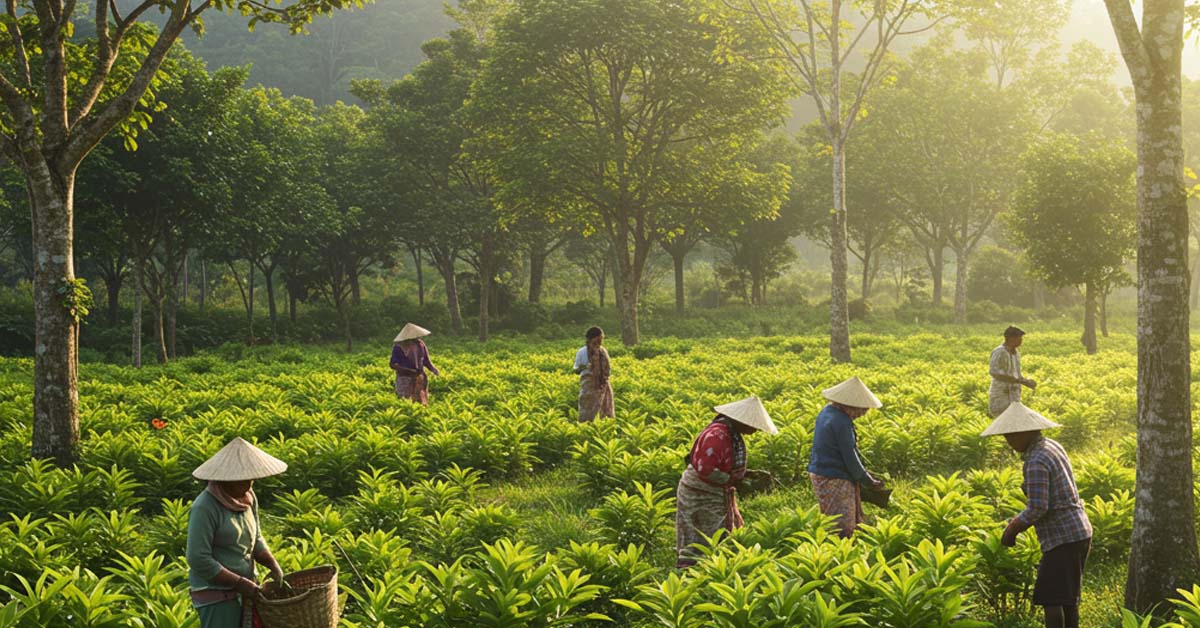Cardamom, often referred to as the Queen of Spices, is not only known for its unique flavor and fragrance but also for its environmental significance. As demand for cardamom continues to grow globally, there is a shift toward more sustainable farming practices to ensure that cardamom farming contributes to the health of the environment, rather than depleting it.
Sustainable cardamom farming incorporates methods that protect ecosystems, reduce carbon footprints, and promote biodiversity. In this blog, we’ll explore how sustainable cardamom farming can have a positive impact on the environment. 🌍
What Is Sustainable Cardamom Farming? 🌱
Sustainable farming refers to agricultural practices that meet the current needs of farmers and consumers without compromising the ability of future generations to meet their own needs. In cardamom farming, this involves the responsible use of resources, promoting environmental conservation, and reducing environmental harm.
Sustainable practices include:
- Reducing chemical inputs like synthetic fertilizers and pesticides.
- Conserving water resources.
- Protecting soil health.
- Promoting biodiversity through agroforestry and crop diversification.
By adopting these practices, farmers can grow cardamom in a way that is environmentally friendly, economically viable, and socially responsible. 🌍
Key Environmental Benefits of Sustainable Cardamom Farming 🌳
1. Protection of Soil Health 🌿
Soil is the foundation of healthy crop production. Sustainable cardamom farming methods focus on maintaining and enhancing soil health. Traditional farming often relies on monocropping and heavy use of chemical fertilizers, which can deplete the soil of its nutrients. In contrast, sustainable farming methods use practices like:
- Organic fertilizers (e.g., compost, animal manure) to enrich the soil.
- Crop rotation and agroforestry to promote natural soil replenishment.
- Cover crops that protect the soil and improve its structure.
These practices help maintain soil fertility, prevent erosion, and ensure long-term productivity, benefiting both the environment and the farmer. 🌱
2. Reduction of Chemical Use 🚫💊
Traditional cardamom farming often depends on synthetic pesticides and fertilizers, which can have harmful effects on the surrounding ecosystem, water bodies, and even human health. Sustainable farming practices aim to:
- Minimize chemical pesticide use by utilizing natural pest control methods (e.g., encouraging beneficial insects or using organic pest repellents).
- Reduce reliance on synthetic fertilizers by using organic alternatives, which improve soil health and reduce water contamination.
By minimizing chemicals, sustainable cardamom farming reduces pollution and promotes the health of the surrounding ecosystem, including the water supply, soil organisms, and local wildlife. 🌍
3. Conservation of Water Resources 💧
Water scarcity is one of the most pressing environmental challenges faced by farmers worldwide. Sustainable cardamom farming places a strong emphasis on efficient water use and conservation. Practices like:
- Rainwater harvesting to collect and store rainwater for irrigation.
- Drip irrigation to provide precise amounts of water directly to the root zone.
- Soil mulching to retain moisture and reduce evaporation.
These methods help farmers use water efficiently, reduce the overall water footprint, and ensure that the land remains productive even in regions with limited water availability. 💦
4. Preservation of Biodiversity 🦋🌿
Biodiversity is crucial for maintaining healthy ecosystems. Sustainable cardamom farming supports biodiversity in several ways:
- Agroforestry: The practice of planting trees alongside crops helps create a diverse ecosystem that supports a wide range of species, including pollinators, birds, insects, and beneficial microorganisms.
- Crop diversification: Growing multiple crops alongside cardamom increases the resilience of the farm and reduces the risk of pests and diseases.
- Habitat protection: By avoiding deforestation and maintaining natural habitats, sustainable farmers help protect local wildlife and preserve native plant species.
A diverse farm ecosystem helps create a natural balance, reducing the need for harmful chemical inputs and contributing to the long-term health of the environment. 🌻
5. Carbon Sequestration 🌳
One of the most significant environmental benefits of sustainable farming is its role in carbon sequestration. Trees and plants absorb carbon dioxide (CO2) from the atmosphere, which helps mitigate climate change. In cardamom farming, agroforestry systems play a vital role in sequestering carbon:
- Tree canopies help reduce the carbon footprint of farming activities by absorbing excess carbon.
- Healthy soils (with organic matter and better structure) also act as carbon sinks.
By using trees and other plants to absorb and store carbon, sustainable cardamom farming helps combat the global climate crisis. 🌍
6. Climate Change Mitigation 🌦️
Sustainable farming practices also contribute to climate change mitigation. By adopting climate-resilient farming techniques, cardamom farmers can adapt to changing weather patterns, such as droughts, heavy rainfall, and temperature shifts. This may include:
- Planting drought-resistant cardamom varieties or other companion plants that can withstand extreme weather conditions.
- Creating shade cover with trees to protect crops from extreme heat.
- Using soil conservation techniques to retain moisture during dry spells.
These strategies help protect cardamom crops and safeguard the environment from the negative impacts of climate change. 🌡️
How Farmers Can Transition to Sustainable Practices 🌱
Transitioning to sustainable cardamom farming may seem daunting, but it is achievable. Here are a few steps farmers can take to get started:
- Educate Yourself: Learn about sustainable practices, such as agroforestry, organic farming, and water management.
- Start Small: Begin with a small area of your farm to test different sustainable practices before scaling them up.
- Use Organic Inputs: Switch to organic fertilizers and natural pest control methods.
- Embrace Agroforestry: Integrate trees alongside your cardamom crops to improve soil health, increase biodiversity, and provide shade.
- Conserve Water: Implement water-saving techniques like drip irrigation, rainwater harvesting, and mulching.
By making small changes, cardamom farmers can contribute to a more sustainable and environmentally-friendly future for both their farms and the planet. 🌍
🌱 Conclusion 🌍
Sustainable cardamom farming offers immense benefits to the environment, from soil health and biodiversity preservation to carbon sequestration and climate change mitigation. By reducing chemical inputs, conserving water, and embracing practices like agroforestry, farmers can contribute to the long-term health of both the planet and their crops.
At Greengold Guide, we believe in promoting sustainable and high-quality cardamom products. If you’re looking for premium cardamom, visit our page to explore our offerings and support sustainable farming practices! 🌱💚













